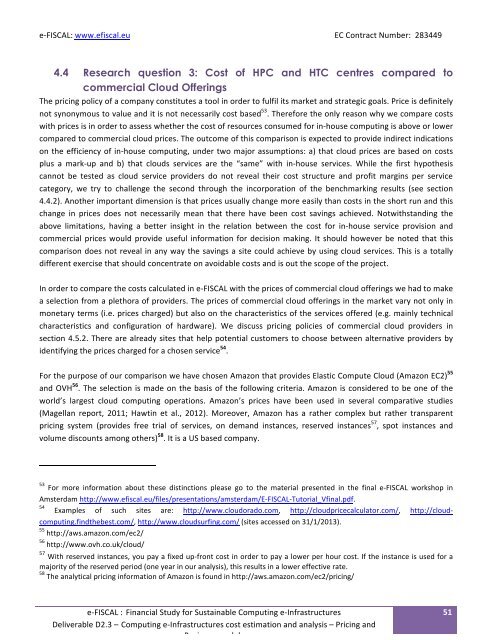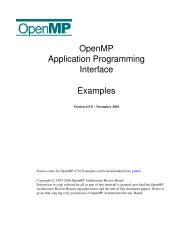D2 3 Computing e-Infrastructure cost calculations and business _models_vam1-final
D2 3 Computing e-Infrastructure cost calculations and business _models_vam1-final
D2 3 Computing e-Infrastructure cost calculations and business _models_vam1-final
Create successful ePaper yourself
Turn your PDF publications into a flip-book with our unique Google optimized e-Paper software.
e-‐FISCAL: www.efiscal.eu <br />
EC Contract Number: 283449 <br />
4.4 Research question 3: Cost of HPC <strong>and</strong> HTC centres compared to<br />
commercial Cloud Offerings<br />
The pricing policy of a company constitutes a tool in order to fulfil its market <strong>and</strong> strategic goals. Price is definitely <br />
not synonymous to value <strong>and</strong> it is not necessarily <strong>cost</strong> based 53 . Therefore the only reason why we compare <strong>cost</strong>s <br />
with prices is in order to assess whether the <strong>cost</strong> of resources consumed for in-‐house computing is above or lower <br />
compared to commercial cloud prices. The outcome of this comparison is expected to provide indirect indications <br />
on the efficiency of in-‐house computing, under two major assumptions: a) that cloud prices are based on <strong>cost</strong>s <br />
plus a mark-‐up <strong>and</strong> b) that clouds services are the “same” with in-‐house services. While the first hypothesis <br />
cannot be tested as cloud service providers do not reveal their <strong>cost</strong> structure <strong>and</strong> profit margins per service <br />
category, we try to challenge the second through the incorporation of the benchmarking results (see section <br />
4.4.2). Another important dimension is that prices usually change more easily than <strong>cost</strong>s in the short run <strong>and</strong> this <br />
change in prices does not necessarily mean that there have been <strong>cost</strong> savings achieved. Notwithst<strong>and</strong>ing the <br />
above limitations, having a better insight in the relation between the <strong>cost</strong> for in-‐house service provision <strong>and</strong> <br />
commercial prices would provide useful information for decision making. It should however be noted that this <br />
comparison does not reveal in any way the savings a site could achieve by using cloud services. This is a totally <br />
different exercise that should concentrate on avoidable <strong>cost</strong>s <strong>and</strong> is out the scope of the project. <br />
In order to compare the <strong>cost</strong>s calculated in e-‐FISCAL with the prices of commercial cloud offerings we had to make <br />
a selection from a plethora of providers. The prices of commercial cloud offerings in the market vary not only in <br />
monetary terms (i.e. prices charged) but also on the characteristics of the services offered (e.g. mainly technical <br />
characteristics <strong>and</strong> configuration of hardware). We discuss pricing policies of commercial cloud providers in <br />
section 4.5.2. There are already sites that help potential customers to choose between alternative providers by <br />
identifying the prices charged for a chosen service 54 . <br />
For the purpose of our comparison we have chosen Amazon that provides Elastic Compute Cloud (Amazon EC2) 55<br />
<strong>and</strong> OVH 56 . The selection is made on the basis of the following criteria. Amazon is considered to be one of the <br />
world’s largest cloud computing operations. Amazon’s prices have been used in several comparative studies <br />
(Magellan report, 2011; Hawtin et al., 2012). Moreover, Amazon has a rather complex but rather transparent <br />
pricing system (provides free trial of services, on dem<strong>and</strong> instances, reserved instances 57 , spot instances <strong>and</strong> <br />
volume discounts among others) 58 . It is a US based company. <br />
53 For more information about these distinctions please go to the material presented in the <strong>final</strong> e-‐FISCAL workshop in <br />
Amsterdam http://www.efiscal.eu/files/presentations/amsterdam/E-‐FISCAL-‐Tutorial_V<strong>final</strong>.pdf. <br />
54<br />
Examples of such sites are: http://www.cloudorado.com, http://cloudpricecalculator.com/, http://cloud-computing.findthebest.com/,<br />
http://www.cloudsurfing.com/ (sites accessed on 31/1/2013). <br />
55 http://aws.amazon.com/ec2/ <br />
56 http://www.ovh.co.uk/cloud/ <br />
57 With reserved instances, you pay a fixed up-‐front <strong>cost</strong> in order to pay a lower per hour <strong>cost</strong>. If the instance is used for a <br />
majority of the reserved period (one year in our analysis), this results in a lower effective rate. <br />
58 The analytical pricing information of Amazon is found in http://aws.amazon.com/ec2/pricing/ <br />
e-‐FISCAL : Financial Study for Sustainable <strong>Computing</strong> e-‐<strong>Infrastructure</strong>s <br />
Deliverable <strong>D2</strong>.3 – <strong>Computing</strong> e-‐<strong>Infrastructure</strong>s <strong>cost</strong> estimation <strong>and</strong> analysis – Pricing <strong>and</strong> <br />
Business <strong>models</strong> <br />
51




